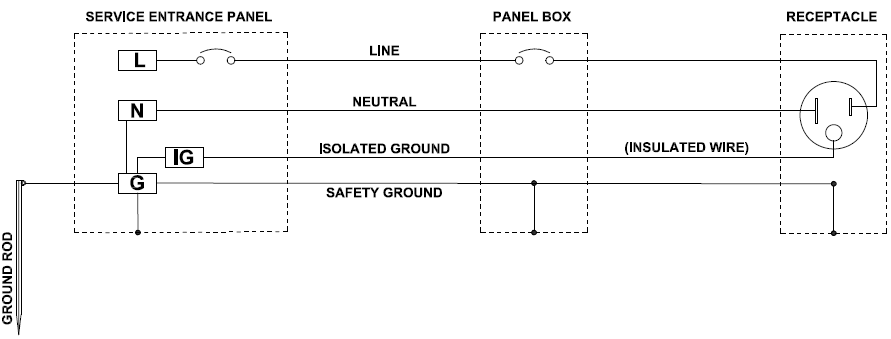When interference from electromagnetic sources needs to be managed on the ground circuit of a particular load or sensitive electronic equipment, National Electric Code (North America) permits use of receptacle in which ground terminal is insulated from receptacle metal structure. Relevant code section is NEC 250.146 (D) or 250.96 (B).
An isolated grounded (IG) or isolated grounded receptacles is one in which there is no direct electrical connection between ground terminal on the receptacle and any other metal part of the assembly, conduit etc. except at the source ground. NEC requires that IG receptacles be identified by an orange ∆. Many manufactures make the IG receptacles entirely orange color. Use of IG receptacle does not relieve the requirement that metal box and all other metallic structures be safety grounded.
How does IG receptacle help reduce noise?

Basic idea behind isolated ground is to have a fully insulated ground wire from receptacle all the way back to the source ground. Insulated ground wire can ‘pass through’ one or more intermediate panel boxes without making electrical connection. The ground for the protected equipment will be at the potential of remote source ground and ideally is not influenced by stray current flowing in safety ground. Stray currents are always present in ground wires due to leaking current from electronic circuits. These currents will cause ground potential rise (few mV to few volts usually) between receptacle ground and the source ground. By having IG wire directly connected to the source ground we remove the ground potential from our sensitive electronic load.
Read: Ground Potential Rise
Even with IG receptacle, metal box still needs to be safety grounded as usual. System now has two ground conductors in addition to phase and neutral wires. This makes the 120V receptacle a four-conductor system (Line + Neutral + Isolated ground + Safety ground) with all four wires in same cable or conduit.

Isolated ground wire needs to be insulated according to the voltage level all the way from service entrance to receptacle. Care should be taken to prevent unintentional contact between isolated ground and safety ground except at the service entrance panel as this will defeat the purpose of having IG receptacle. Safety ground wire can be bare or insulated, it doesn’t matter.
Are there any benefits to using IG receptacle?
NEC code does not discuss any benefits of using IG receptacle nor it is universally agreed upon. Results range from no improvement to some improvement to increased noise. Noise improvement if achieved will be reduction of common mode noise (noise between neutral and ground) and not to differential mode noise.
When distance from the receptacle to source ground is very long (100’s of feet) or is connected to a separate building then there is a possibility of having difference of potential between IG ground and safety ground during lightning transients. This could show up as a shock hazard between isolated equipment frame and other grounded surfaces.
What are the other alternatives to using IG receptacle?
Consider a separate branch circuit, a Zero Signal Reference Plane (ZSRP) or use an isolation transformer to produce a separately derived system will give better noise performance. These can be used in combination with IG to reduce noise.
